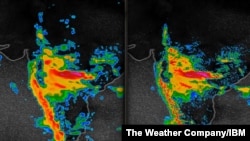As more extreme weather takes its toll around the world, computer giant IBM says it is making a breakthrough in precision weather forecasting available to everyone.
The company said the new high-resolution forecasts bring a level of precision previously available only in major industrialized countries.
It is expected to help emergency managers better predict where severe storms will strike, as well as aid airlines planning flight paths and farmers tending crops. Not to mention commuters deciding whether to carry an umbrella.
The new system generates forecasts more frequently and with finer details than what’s available outside the United States, Europe and Japan.
WATCH: Better Weather Forecasts Coming to the Developing World
Most forecasts have a resolution of 10 to 15 square kilometers and update every six to 12 hours. IBM’s Global High-Resolution Atmospheric Forecasting System (GRAF) goes down to 3 square kilometers and updates every hour.
“That’s providing a level of detail that we’ve not been able to see in parts of the world such as Southeast Asia, Africa as well as South America,” said Kevin Petty, director of science and forecasting at IBM-owned The Weather Company.
That precision can reveal details of where and when extremely heavy rain will fall. That could be useful in emergency situations, as well as more mundane events. It could help farmers decide when to plant, harvest and fertilize, for example.
Better forecasts around globe
“I think it’s a pretty large achievement,” said University of Oklahoma emeritus meteorology professor Fred Carr, who was not involved with the project.
The United States has a similar high-resolution system, “but it’s just for the U.S. because it takes so much computer time,” Carr said. “To do it for the whole globe is a pretty significant achievement.”
The Weather Company’s Petty said, “We are just now getting to the point of having the level of computational power to do this.”
GRAF runs the National Center for Atmospheric Research’s state-of-the-art open-source weather model on high performance supercomputers.
Forecasts are only as good as the observations that go into them, Carr said.
Finding, filling the gaps
It’s possible to quickly collect observations from radar, airplanes and surface measurements in the United States, he added, but it’s not apparent how IBM gets data from the other 98% of the globe, especially in areas that currently don’t have extensive weather systems.
Carr said he suspects “there’s gonna be gaps, or failures, or problems sometimes in getting those data in. So, sometimes those forecasts aren’t going to be very accurate.”
Users will be able to decide for themselves. The system now runs on Weather.com and The Weather Channel smartphone app.
In the future, IBM hopes to improve its forecasts by collecting data from atmospheric pressure sensors that are now standard equipment in smartphones.
These sensors improve the accuracy of GPS. They can help fitness trackers calculate how many flights of stairs the user has climbed, for example.
IBM said it is not currently using this data but plans to offer users the opportunity to opt in.
This kind of data collection from tech companies has drawn scrutiny from privacy advocates. The city of Los Angeles is currently suing IBM for improperly using location information from Weather Channel app users.










